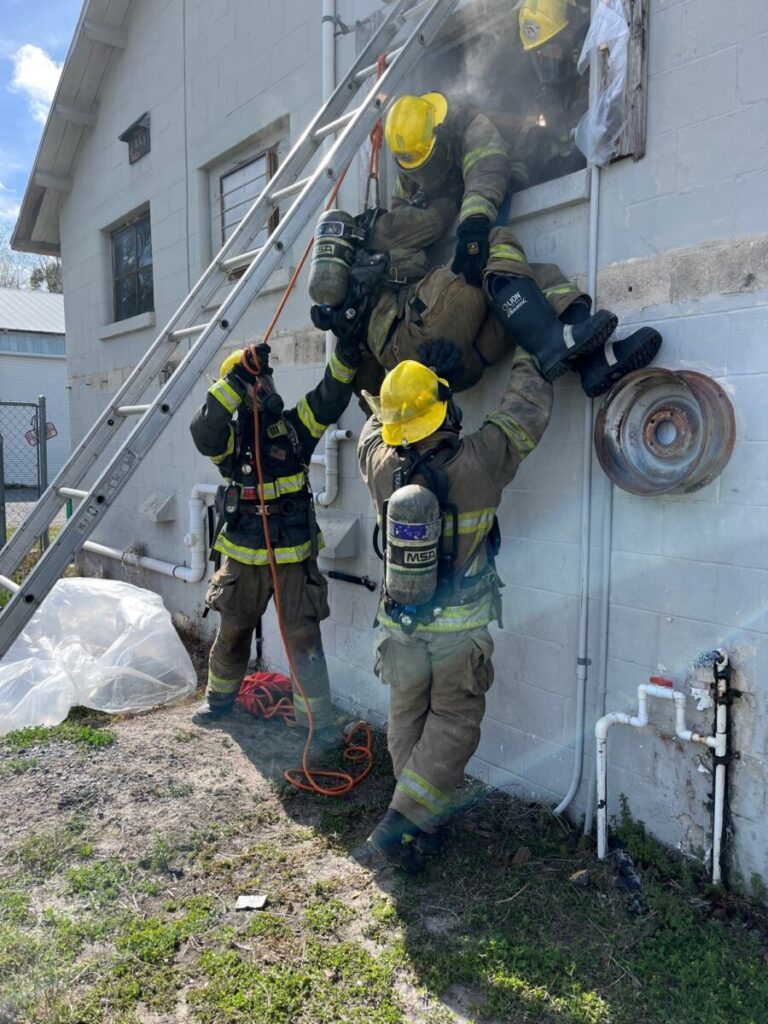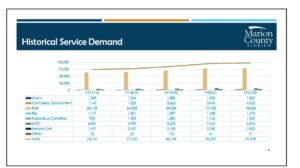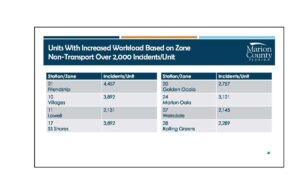NEEDS, NOT WANTS
MCFR outlines the department’s significant list of needs for people, buildings and equipment to the county commission.

New firefighter recruits train. [supplied by MCFR]
Marion County Fire Rescue leaders recently shared with Marion County commissioners their multimillion list of what they emphasized are needs, not wants, in order to provide fire services to the growing county in the coming years.
To build new stations and remodel others, MCFR would need $117 million over the next 15 years, officials told the Board of County Commissioners at the April 6 budget workshop. At least two stations, they said, are needed immediately. With new fire trucks, ambulances, and additional staff positions to run the vehicles, the fire department estimates a budget need of $134,750,000.
As stark as these figures are, they do not account for inflation or expected increases in payroll. MCFR has been struggling to attract and keep workers due to a competitive market for the fewer firefighters and paramedics who are entering the field.
MCFR officials told the board they were not holding back communicating their needs, but the workshop didn’t fully address the most critical element for improving the current department crisis: people.
Current staffing situation
As previously reported, numerous MCFR employees have resigned from the department over the past five years:
2018 -54 2019-33 2020-46 2021-67
2022-72 2023YTD-4
TOTAL 276
These numbers do not include 68 others who either retired or were transferred or fired over the past five years.
The reason for the significant level of resignations is attributed primarily to workers seeking higher wages in neighboring counties.
MCFR, which handles all ambulance transport in Marion County, even though Ocala Fire Rescue serves the city, needs 175 personnel to staff each shift with the current station and emergency vehicle capacity. That breaks down to eight commanding officers, 72 engine operators, nine assigned to ladder/tower firefighters, six to heavy rescue, 54 dual-certified Paramedic/Firefighters and 26 singled-certified EMS/Firefighters.
Fire Chief James Banta told the commission, “There are 492 budgeted positions. Currently, there are 458 of those positions filled for a vacancy of roughly 34 positions.”
However, Banta explained, those numbers need context when it comes to understanding how many boots on the ground are currently available. Of the 458 employees, “33 … are in fire school right now, so they’re not on the truck. While it says it’s a position that’s filled, they’re not on the truck and they’re not going to be there for several months.
“On our EMS single-certified of the side of the house,’’ he said, “of the 109 budgeted positions we are at 93 (filled) and 16 are vacant. You can see where we’re dealing with a significant amount of openings each day, roughly 27.666 repeating.”
Unique to the MCBCC is one commissioner, Jeff Gold, who is himself is a firefighter paramedic, and worked for MCFR in 1984-1990, before heading to Marion County Sheriff’s Office for 25 years. Even as a commissioner, he still works part time in other neighboring areas. Gold has a Master’s degree from UF related to fire emergency services and holds many state certifications.
“My biggest problem with our strategy over the years is that we are filling vacancies through recruiting non-certified firefighters. It’s a three-year project- we put them through fire school, EMT school, and then paramedic school- only they leave for another department, and we are back to where we started. We are temporarily filling the positions to get the vacancies off our books- rather than recruiting people that can work now,” Gold told the “Gazette”.
The department’s medical director, Frank A Fraunfelter, M.D., wrote a memo the commissioners received last fall, “Losing and having to replace experienced paramedics with new graduate paramedics is a big morale and liability concern,’’ he wrote. “Placing inexperienced providers into life-threatening decisions without supervision can be detrimental to lives and our community as a whole. A new paramedic is learning the skills necessary to provide high-level care while still gaining the clinical experience to provide top-level care that all of our citizens deserve. Without an experienced workforce, the lack of mentoring from senior medics will be damaging to our county, department and paramedics.”
Increased need for services
According to information provided by MCFR, meeting community needs has been exacerbated by significant increases in the population of Marion County and the number of service calls that are being generated as a result.
One of the slides shared during the presentation indicated that service calls from 2017-18 to the 2021-22 period increased by more than 30%.

In 2010, each MCFR budgeted position had 113 incidents associated with it annually. From 2012 until 2020, the budgeted positions in the department dropped while the incidents associated with each budgeted position increased by approximately 45%. In 2020, the county increased MCFR budgeted positions from 506 to 565.
For these statistics, MCFR included both certified and noncertified supporting roles. But as of last year, incidents per position had increased since 2010 more than 50% totaling 173 incidents per position.
MCFR officials said they have been exploring several ways to cut the demand for services. One change has been having local hospitals handle all interfacility transfers, which deviates from contracts the county has had with hospitals to provide transport. Thus far, AdventHealth had been handling 90% of its own transports, and Ocala Regional Medical Center has increased its capacity from 60% to 90% during this last quarter.
Another idea has been a re-evaluation of what type of vehicle to send to calls, moving away, for example, from sending both a fire truck and ambulance to a traffic accident scene when other response vehicles could handle the situation.
MCFR encouraged the commissioners also to increase funding for the community paramedic program that proactively treats those so-called ambulance “frequent flyers” who don’t necessarily need emergency care just access to routine health care.
MCFR leaders also suggested a public information campaign explaining the appropriate use of the 911 system; a nurse to triage nonemergency medical requests received at Public Safety Communications; and possibly integrating more telehealth for nonemergency medical requests.
Need for more and better fire stations
MCFR leaders also identified a substantial need for new or updated stations. Categorizing stations as either Excellent, Good, Fair or Poor, more than half the county’s stations were deemed Fair or Poor.
MCFR considered nine of the stations they rated “poor” under this criterion: Appears to be cosmetically weathered and worn with potentially structural defects, although not imminently dangerous or unsafe. Large, multiple full-thickness cracks and crumbling of concrete on the apron may exist. The roof has evidence of leaking and/or multiple repairs. Interior is poorly maintained or showing signs of advanced deterioration with moderate to significant nonstructural defects. Problematic age-related maintenance and/or major defects are evident. May not be well suited to its intended purpose. Age is typically greater than 40 years.
MCFR officials mentioned they didn’t only need more living quarters to accommodate more employees but better-planned living quarters. Some of the older stations previously intended for volunteer workers did not allow for uninterrupted sleep when calls came in—a serious concern when it came to protecting the mental health of its employees. Other considerations related to stations were a lack of storage space for bunker gear and response vehicles.
The need for better equipped stations became especially important for some units that were receiving calls twice the volume considered safe.

Additionally, it was mentioned more than once during the workshop that ISO ratings impact homeowners’ insurance premiums, and those ratings are directly correlated to how close a home is to a fire station.
Emergency vehicles and gear
Over the next 15 years, MCFR recommends purchasing 30 new engine trucks at a rate of two per year. Each fire engine comes at a cost of $900,000 in today’s market and requires staffing to operate each truck at an annual cost of $1.2 million.
They estimated the need for 135 ambulances at the rate of nine per year. Each ambulance comes at $450,000 and comes with an annual staffing cost of $650,000.
Bunker gear related to cancer prevention was also a budget item discussed; a second set of gear is ideal. The department has been budgeting some for the gear a little every year but currently, 274 employees still need a second set, at an estimated cost of $863,000.
Funding
MCFR identified three funding obstacles.
In regard to funding for competitive wages and additional staff, building new stations and buying new emergency vehicles and gear, MCFR proposed that commissioners consider adjusting the fire assessment fee, adjust general fund millage, implement fire impact fees and/or give the department the benefit of “available funds in budget from impact fees.”
The collection of impact fees, however, won’t provide a quick funding solution for the multitude of demands brought on by the growing population.
In 2021, Gov. Ron DeSantis implemented changes that restrict local governments from increasing impact fees more than once every four years and then only by 50%. Any increases that come in between 25 and 50% would have to be spread over four years.
At the time DeSantis signed the bill, the environmental group 1000 Friends of Florida said the measure made it “virtually impossible for local governments to require that new development pays its own way.”
The commissioner chair, Craig Curry, expressed a desire to have more one on one talks with MCFR’s rank and file to understand better the issues that were negatively impacting the culture of MCFR.
Commissioners Michelle Stone and Kathy Bryant expressed thanks to MCFR for their service.
Another workshop is expected to address how to address budget concerns for MCFR’s mounting needs.
Immediate future
Toward the end of the workshop, Commissioner Kathy Bryant prefaced a question as “the most important one” she’d ask that day: “What’s more important, shoring up the people or shoring up the stuff?”
To which Banta answered, “People. You got to start with the people.”
“I figured that’s what it was. But I wanted it on the record,” responded Bryant.
The county and fire union are currently negotiating wages in hopes of answering the complaint that Marion County wages are not competitive and the main reason for so many resignations- that leave the department shorthanded and firefighters having to work so many extra shifts.
In a statement issued to the “Gazette” from the Professional Firefighters of Marion County it says they were “hopeful” for the future of Marion County Fire Rescue (MCFR) now that it had been acknowledged “how inadequate the department is when it comes to staff, stations and equipment.”
“The Professional Firefighters have sounded the alarm on a pending staffing crisis since last December, when then-President Daniel Garcia addressed the board, outlining the rising overtime costs and crushing, ever-increasing workload across 1,600-sq. miles of a post-covid Marion County,” they wrote.
“The Professional Firefighters of Marion County have continuously worked to improve the working conditions and benefits for MCFR’s valued public safety responders. We hope to partner with the Marion County Board of County Commissioners in recruiting and retaining the best and brightest first responders in Florida, instead of continually losing our valued, experienced staff to better pay and healthier working environments.”





